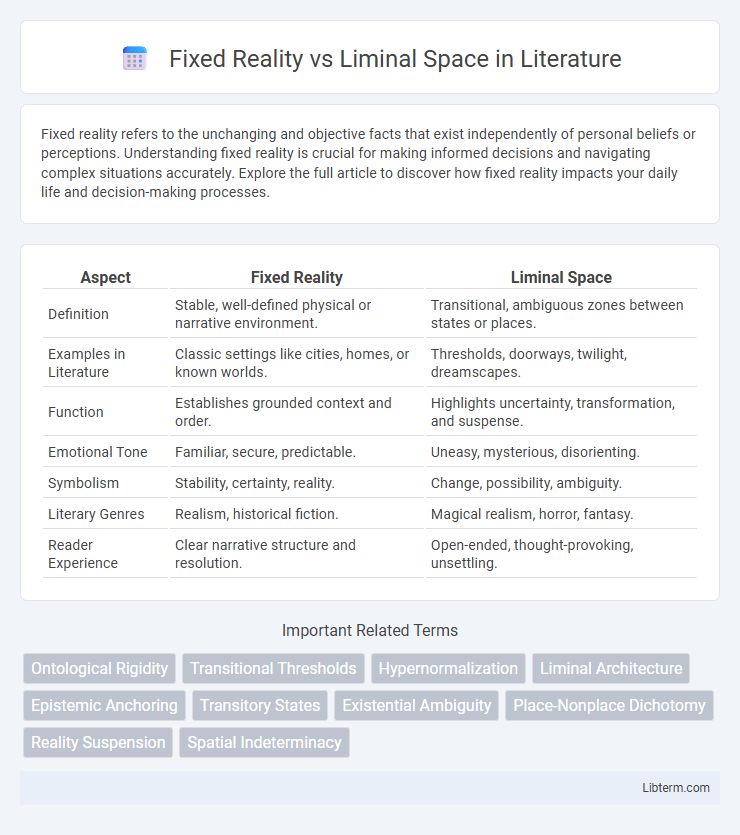Fixed reality refers to the unchanging and objective facts that exist independently of personal beliefs or perceptions. Understanding fixed reality is crucial for making informed decisions and navigating complex situations accurately. Explore the full article to discover how fixed reality impacts your daily life and decision-making processes.
Table of Comparison
| Aspect | Fixed Reality | Liminal Space |
|---|---|---|
| Definition | Stable, well-defined physical or narrative environment. | Transitional, ambiguous zones between states or places. |
| Examples in Literature | Classic settings like cities, homes, or known worlds. | Thresholds, doorways, twilight, dreamscapes. |
| Function | Establishes grounded context and order. | Highlights uncertainty, transformation, and suspense. |
| Emotional Tone | Familiar, secure, predictable. | Uneasy, mysterious, disorienting. |
| Symbolism | Stability, certainty, reality. | Change, possibility, ambiguity. |
| Literary Genres | Realism, historical fiction. | Magical realism, horror, fantasy. |
| Reader Experience | Clear narrative structure and resolution. | Open-ended, thought-provoking, unsettling. |
Understanding Fixed Reality: Definition and Concepts
Fixed reality refers to a stable, consistent environment governed by unchanging physical laws and objective facts, forming the foundation for everyday experiences. It contrasts with liminal space, which represents transitional or ambiguous zones where normal rules and perceptions may blur. Understanding fixed reality involves recognizing its role in providing certainty, enabling predictable interactions, and anchoring human cognition and behavior within a defined framework.
What is Liminal Space? Unveiling the In-Between
Liminal space refers to transitional or in-between environments that evoke a sense of uncertainty and ambiguity, often characterized by empty hallways, deserted malls, or twilight zones. These spaces challenge fixed reality by existing on the threshold between familiar and unknown, provoking introspection and altered perception. In contrast to fixed reality's defined parameters, liminal spaces represent ambiguity, transformation, and the potential for change.
Historical Context: Fixed Reality vs Liminal Experience
Fixed reality often refers to established historical narratives rooted in tangible events and documented facts, emphasizing continuity and permanence. Liminal space, in historical context, represents transitional periods or states where boundaries are ambiguous, such as the Renaissance or the aftermath of revolutions, offering fluidity and transformation between known eras. Understanding history through the lens of liminal experience allows for deeper insight into cultural shifts and societal evolution beyond fixed timelines.
Psychological Effects of Fixed Reality
Fixed reality, characterized by stable and predictable environments, fosters a strong sense of security and mental grounding, reducing anxiety and cognitive dissonance. This consistency supports routine formation, enhances focus, and promotes emotional regulation by providing clear contextual cues for behavior and decision-making. Psychological stability in fixed reality helps individuals maintain a coherent identity and reduce feelings of uncertainty or existential distress.
Emotional Resonance in Liminal Spaces
Liminal spaces evoke strong emotional resonance by embodying transition and ambiguity, triggering feelings of nostalgia, unease, or curiosity. Unlike fixed reality, which anchors perception in concrete, familiar settings, liminal spaces occupy thresholds that challenge stability and invite introspection. This emotional ambiguity enhances the psychological impact of environments such as empty hallways, deserted airports, or twilight landscapes, making them powerful stimuli for memory and subconscious reflection.
Visual Representations: Art and Imagery of Both Worlds
Fixed Reality often features clear, structured visuals with precise lines and defined perspectives, emphasizing stability and familiarity in art and imagery. In contrast, Liminal Space imagery captures transitional moments with blurred boundaries, ambiguous lighting, and surreal elements, evoking uncertainty and the feeling of being between dimensions. Artists use these contrasting visual cues to highlight the stark difference between the grounded nature of Fixed Reality and the eerie, shifting qualities of Liminal Spaces.
Cultural Interpretations: How Societies View the Divide
Fixed reality often represents concrete societal norms and established cultural values that define collective identity and stability. Liminal space embodies transitional, ambiguous zones where societies confront uncertainty, transformation, and the potential for new cultural meanings to emerge. Different cultures interpret this divide through rituals, mythology, and social practices that either reinforce fixed boundaries or embrace liminality as a vital space for innovation and change.
Fixed Reality in Daily Life
Fixed Reality in daily life refers to the structured, predictable environment governed by concrete rules, physical laws, and consistent social norms that shape human behavior and interactions. This reality is characterized by stability and order, enabling individuals to navigate routines such as work, transportation, and communication with reliability and efficiency. Understanding Fixed Reality helps anchor people amidst changing circumstances, providing a framework for decision-making and social cohesion.
The Allure of Liminal Spaces in Modern Media
Liminal spaces captivate modern media audiences by evoking feelings of transition, mystery, and eeriness through their portrayal of undefined or in-between places. Unlike fixed reality, which depicts stable and concrete environments, liminal spaces emphasize ambiguity and potential transformation, often symbolizing psychological or existential thresholds. This allure enhances narratives by tapping into viewers' subconscious associations with change, uncertainty, and the uncanny nature of forgotten or transient locations.
Navigating Between Realms: Embracing Ambiguity
Navigating between fixed reality and liminal space requires embracing ambiguity as a vital tool for understanding transitional states and blurred boundaries. Fixed reality offers concrete and stable environments, whereas liminal space embodies uncertainty and fluidity, challenging perceptions and encouraging adaptive thinking. Embracing ambiguity allows individuals to move fluidly between these realms, fostering creativity, resilience, and a deeper awareness of the complexities within human experience.
Fixed Reality Infographic

 libterm.com
libterm.com